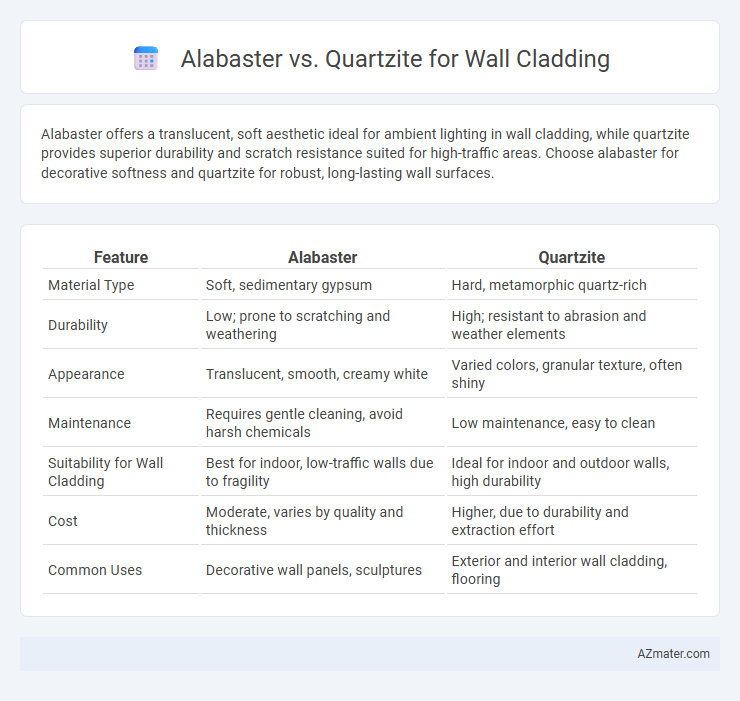Alabaster offers a translucent, soft aesthetic ideal for ambient lighting in wall cladding, while quartzite provides superior durability and scratch resistance suited for high-traffic areas. Choose alabaster for decorative softness and quartzite for robust, long-lasting wall surfaces.
Table of Comparison
| Feature | Alabaster | Quartzite |
|---|---|---|
| Material Type | Soft, sedimentary gypsum | Hard, metamorphic quartz-rich |
| Durability | Low; prone to scratching and weathering | High; resistant to abrasion and weather elements |
| Appearance | Translucent, smooth, creamy white | Varied colors, granular texture, often shiny |
| Maintenance | Requires gentle cleaning, avoid harsh chemicals | Low maintenance, easy to clean |
| Suitability for Wall Cladding | Best for indoor, low-traffic walls due to fragility | Ideal for indoor and outdoor walls, high durability |
| Cost | Moderate, varies by quality and thickness | Higher, due to durability and extraction effort |
| Common Uses | Decorative wall panels, sculptures | Exterior and interior wall cladding, flooring |
Introduction to Alabaster and Quartzite Wall Cladding
Alabaster wall cladding offers a translucent, soft, and luxurious aesthetic, prized for its smooth texture and warm glow when backlit, making it ideal for elegant interiors. Quartzite wall cladding provides superior durability and hardness, with a natural, crystalline appearance that features varied patterns and colors suitable for high-traffic or exterior applications. Both materials serve distinct design and functional purposes, with alabaster favored for decorative appeal and quartzite for strength and weather resistance.
Key Material Properties of Alabaster
Alabaster is a soft, translucent mineral known for its fine grain and smooth texture, making it ideal for decorative wall cladding that enhances ambient lighting through its natural translucency. Its low hardness level, typically around 2 on the Mohs scale, requires careful handling and sealing to prevent damage from moisture and abrasion. Alabaster's unique ability to diffuse light provides a warm, glowing effect unmatched by harder stones like quartzite, which is significantly more durable but lacks this luminous quality.
Essential Characteristics of Quartzite
Quartzite is an incredibly durable and dense natural stone, composed primarily of quartz, which makes it highly resistant to scratching and weathering for wall cladding applications. Its hardness, rated around 7 on the Mohs scale, ensures longevity and structural integrity, making it ideal for both interior and exterior surfaces. The stone's low porosity also provides excellent resistance to stains and moisture, contributing to its suitability in various environmental conditions.
Aesthetic Appeal: Alabaster vs Quartzite
Alabaster offers a translucent, soft glow with smooth, creamy textures that enhance wall cladding with an elegant, ethereal aesthetic. Quartzite features a more rugged, natural stone appearance with vibrant veining and a glossy finish, providing a bold, dynamic look for interior and exterior walls. The choice between alabaster's delicate luminosity and quartzite's striking durability depends on the desired ambiance and design style of the space.
Durability and Longevity Comparison
Alabaster offers an elegant, translucent appearance but has lower durability due to its softness and susceptibility to scratches and stains, making it less ideal for high-traffic wall cladding. Quartzite, composed primarily of quartz, provides exceptional hardness and resistance to weathering, ensuring superior longevity and minimal maintenance in both indoor and outdoor applications. For long-term investment in wall cladding, quartzite's robust durability and resistance to wear significantly outmatch alabaster's aesthetic appeal but fragility.
Installation Requirements and Techniques
Alabaster for wall cladding demands precise handling due to its softness and susceptibility to scratching, requiring gentle cutting tools and specialized adhesives to prevent damage during installation. Quartzite, known for its hardness and durability, allows for more conventional cutting techniques such as wet saws and typically requires heavy-duty anchors or mechanical fasteners to ensure secure attachment to walls. Both materials benefit from professional installation, but quartzite's robustness makes it more adaptable to varied mounting systems and suitable for high-traffic wall surfaces.
Maintenance and Cleaning Needs
Alabaster wall cladding requires gentle cleaning with a soft cloth and non-abrasive, pH-neutral cleaners to prevent surface damage, as it is a softer and more porous material prone to scratching and staining. Quartzite offers higher durability and resistance to stains and scratches, allowing for easier maintenance with mild soap and water, making it ideal for high-traffic areas. Regular sealing of both materials enhances longevity and protects against moisture infiltration and dirt accumulation.
Cost Considerations for Wall Cladding
Alabaster offers a more affordable option for wall cladding with prices typically ranging from $15 to $40 per square foot, making it budget-friendly for decorative interior applications. Quartzite, while more expensive at around $60 to $120 per square foot, provides superior durability and resistance to scratches and heat, justifying higher initial costs for high-traffic or exterior cladding projects. Cost considerations also include installation complexity, as quartzite requires specialized tools and expertise, increasing labor expenses, whereas alabaster's softer texture allows for easier handling and lower installation fees.
Best Use Cases: Residential vs Commercial Applications
Alabaster offers a translucent, soft aesthetic ideal for residential wall cladding, enhancing interior spaces with warm, ambient light diffusion. Quartzite's exceptional hardness and resistance to weathering make it better suited for commercial applications requiring durable, high-traffic surface materials. Choosing between alabaster and quartzite depends on balancing visual appeal and performance needs tailored to either residential elegance or commercial robustness.
Final Verdict: Choosing Between Alabaster and Quartzite
Alabaster offers a soft, translucent appearance ideal for illuminated wall cladding, creating a warm and luxurious ambiance in interior spaces. Quartzite stands out for its exceptional durability and resistance to scratches and heat, making it a practical choice for high-traffic areas and exterior walls. The final verdict depends on whether aesthetic elegance or robust performance is prioritized, with alabaster suited for decorative, low-impact installations and quartzite preferred for long-lasting, maintenance-friendly surfaces.

Infographic: Alabaster vs Quartzite for Wall Cladding
 azmater.com
azmater.com